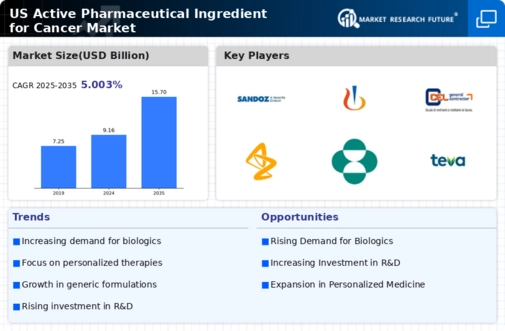The competitive landscape of the US Active Pharmaceutical Ingredient for Cancer Market reveals a dynamic environment characterized by innovation, strategic collaborations, and a focus on enhancing supply chain efficiencies.
As the demand for effective cancer treatments continues to rise, the market is becoming increasingly populated with both established players and emerging companies striving to capture market share. Key drivers influencing competition include the growing prevalence of cancer, advancements in biopharmaceutical technologies, and an increasing emphasis on personalized medicine.
Furthermore, regulatory frameworks and pricing pressures are shaping company strategies as organizations seek to develop high-quality, cost-effective active pharmaceutical ingredients that meet stringent safety and efficacy standards.
This competitive ecosystem necessitates a keen understanding of market trends, customer needs, and ongoing developments in drug formulations to maintain a competitive edge.
Sandoz, a notable player in the US Active Pharmaceutical Ingredient for Cancer Market, has established a solid market presence through its commitment to providing high-quality generic and biosimilar medications. The company has harnessed its strengths in research and development to create a diverse portfolio of oncology products that address critical treatment gaps.
Sandoz's investment in state-of-the-art manufacturing capabilities has positioned it to ensure compliance with regulatory mandates while optimizing production costs. Moreover, the company's extensive distribution network enables it to efficiently deliver its cancer treatment products to healthcare providers and patients across the United States.
Sandoz's strategic partnerships and collaborations with healthcare stakeholders further bolster its market presence and enhance its ability to address unmet medical needs in oncology. Eli Lilly and Company is another significant contender in the US Active Pharmaceutical Ingredient for Cancer Market, with a strong emphasis on developing innovative therapies for cancer treatment.
The company's market presence is marked by a robust pipeline of oncology-related products, including both small molecules and biologics that cater to various cancer types. Eli Lilly's strengths lie in its research capabilities, which have been bolstered by strategic mergers and acquisitions that expand its therapeutic offerings and market reach.
The company has successfully integrated its acquisitions into its operations, enhancing its ability to deliver effective cancer therapies while maintaining a strong focus on safety and patient outcomes.
Eli Lilly's commitment to advancing cancer care is evident through its continued investment in research and development, enabling it to stay at the forefront of emerging trends and technologies within the US Active Pharmaceutical Ingredient for Cancer Market.




















